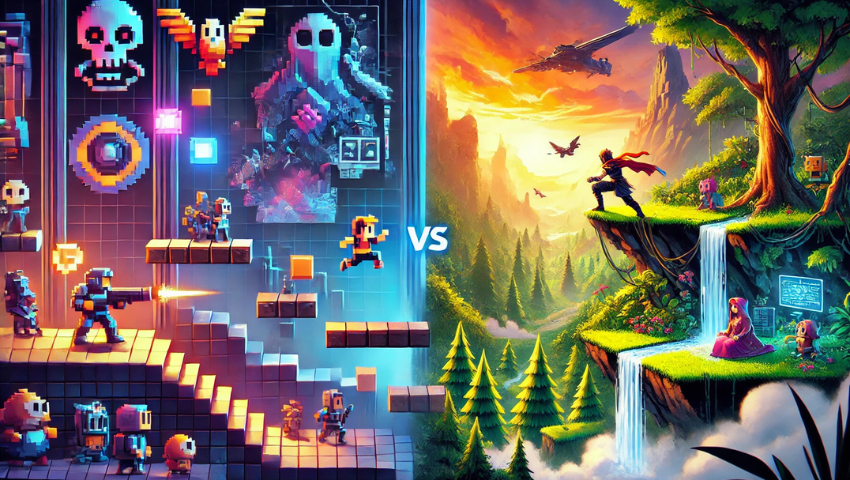When diving into the world of game development, one of the first decisions developers face is whether to create a 2D or 3D game. While both have their unique characteristics and appeal, the choice depends on the game’s vision, technical requirements, and target audience. In this blog, we’ll explore the differences between 2D and 3D games, their advantages, challenges, and when to use each.
What are 2D Games?
“2D games are games that take place in a two-dimensional space. They are characterized by flat graphics where movement is limited to two axes: X (horizontal) and Y (vertical). Examples include classic platformers like Super Mario Bros., side-scrolling shooters, or even puzzle games like Tetris.”
Key Features of 2D Games:
- Simpler Graphics: Focus on sprites and pixel art.
- Straightforward Gameplay: Often more accessible and easier to learn.
- Efficient Development: Quicker to develop compared to 3D games due to fewer assets and technical complexities.
- Nostalgia Factor: Many players associate 2D games with retro gaming.
Advantages of 2D Games:
- Easier for beginners in game development.
- Lower development costs and faster production times.
- Great for mobile platforms or casual games due to lightweight assets.
Challenges of 2D Games:
- Limited visual appeal for players seeking immersive experiences.
- Harder to innovate mechanics compared to 3D environments.
What are 3D Games?
3D games operate in a three-dimensional space, adding depth (Z-axis) to the experience. Players can explore expansive worlds with realistic graphics and dynamic interactions. Examples include popular titles like The Legend of Zelda: Breath of the Wild and Call of Duty.
Key Features of 3D Games:
- Immersive Graphics: Models, lighting, and animations that mimic real-world physics.
- Complex Gameplay: Multiple dimensions allow for innovative mechanics and storytelling.
- Dynamic Camera Angles: Players can experience the game from different perspectives.
Advantages of 3D Games:
- Highly engaging and visually stunning experiences.
- Potential for creating open worlds and deep storytelling.
- Flexibility in gameplay mechanics (e.g., puzzles, combat, exploration).
Challenges of 3D Games:
- More resource-intensive, requiring powerful hardware for development and play.
- Higher costs and longer development cycles.
- Steeper learning curve for developers due to advanced tools and techniques.
Comparison: 2D Games vs. 3D Games
| Aspect | 2D Games | 3D Games |
| Graphics | Flat, sprite-based graphics. | Realistic models and environments. |
| Development Time | Faster and simpler. | Longer and more resource-intensive. |
| Cost | Lower cost; great for indie developers. | Higher cost due to complex assets. |
| Gameplay | Simple and accessible. | Rich and immersive with more depth. |
| Target Audience | Casual and retro gamers. | Players seeking realistic or expansive worlds. |
When to Choose 2D or 3D
Choose 2D Games if:
- You are an indie developer or a beginner looking to create your first game.
- Your game idea is simple and doesn’t require complex mechanics.
- You’re targeting platforms with hardware limitations, such as mobile devices.
Choose 3D Games if:
- You aim to create an immersive and visually stunning experience.
- Your target audience prefers realistic or open-world games.
- You have access to advanced tools, a skilled team, and sufficient budget.
Conclusion
Both 2D and 3D games have their own charm and place in the gaming industry. While 2D games are perfect for quick, engaging experiences, 3D games offer depth and realism for players seeking more immersive adventures. Ultimately, the choice between 2D and 3D depends on your vision, resources, and the audience you wish to captivate.
So, which will it be for your next game? A nostalgic 2D adventure or a breathtaking 3D world? Let us know in the comments below!

